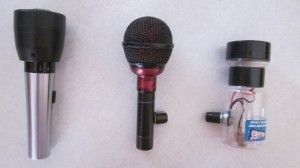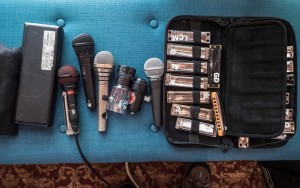
Gear Review: Three mics to do it all
Different mics produce very different sounds, as the samples here show, and no mic by itself can do the best possible job on everything that a harmonica player might want to play. But a harmonica player can cover an amazing range of material and performance situations with 2 or 3 mics, at a total cost of less than $300.
Let’s assume a harmonica player who sings and plays harmonica with a country band and a Chicago blues band, and does occasional rock gigs. This harmonica player needs the following to make the right sounds:
1) A clean vocal mic
2) A clean harmonica mic for the country band
3) A bullet-type mic for the Chicago blues band
Note that if you’re only playing one genre, like Chicago Blues, you might get by very well with one mic. But if you’re playing a lot of different styles, you probably want something that makes it easy to get the sounds that go with each style.
So. We’re looking for 3 mics. Here they are.

A clean vocal mic
Industry standard is the Shure SM58. The thing is built to last, customer service is legendary, the sound is great for vocals, and it costs less than $100. What’s not to like?
A clean harmonica mic for the country band
The best clean harp mic I know of under $200 is the Audix Fireball V, and a lot of more expensive mics don’t sound any better. Great for recording as well as live work. Very low feedback and high volume, very little proximity (increased bass) effect, which also makes it good for rock, especially if you have something in the signal path to dirty it up (like a Digitech RP running my patch set). I used a Digitech RP500 with an Audix Fireball V to record every harp part on my record “The Lucky One”–and it sure sounds good to me.
Make sure to get the Fireball V model, which has a builtin volume control and more bass response. About $125.
A bullet-type mic for the Chicago blues band
When you’re playing blues, it really helps to have a mic that distorts when you’re playing right up against it, and for that you need a bullet type mic. Bullet-type mics also have a frequency response that tops out around 6 kHz, which is a good thing for amped blues harp–plenty of midrange honk and not too much high end screech. The Bottle o’ Blues ($60) is a very good blues mic for the money, a little low on output compared to $100 bullet mics, but you can compensate for that by turning up the amp. An upgraded choice at over $100 is a Shaker harp mic; I like their Dynamic for playing through my Digitech RP, and they’ve got a wide range of harp mics at around $100-150. Brendan Power and Peter “Madcat” Ruth have both said nice things about their Shaker Madcat mics on various harp forums, and the Shaker MadDog is designed to function like a Shaker Madcat with more bass, which is a good thing.

Some players also like the Shure SM57 or SM58, the Shure 545SD, or other “stick” type vocal mics. The sound of these mics is raw and powerful, and they’re in that same $100 price range. (Butterfield used an earlier version of the 545, and Rob Paparozzi uses an SM57 among other mics. I use a 545SD for some blues recordings.) An issue with these vocal mics is that they emphasize treble frequencies, which can be a problem with harp, given that harp already puts out a lot of high frequency stuff, so you might need to mess with EQ if you use one.
Start your mic collection with a mic that’s tops for the stuff you play most
Not everyone can afford to buy three mics at once. If I had to get only one mic to start, I’d ask whether I was planning to play Chicago blues only. If yes, then I’d get the Bottle o’ Blues or a Shaker Dynamic or MadDog. If no, I’d get the Fireball. The Fireball doesn’t do hard blues as well as the Bottle o’ Blues, but it does everything else a hell of a lot better than the Bottle o’ Blues, and it does hard blues more than well enough to get by. (You can hear a recently recorded example by me and my slide guitar-playing brother Mark Hunter, Dyin’ to Live, at this site.) And you can sing through it if you need to. If I was planning to use the mic for recording, I’d get the Fireball for sure.
That all assumes that the harp playing matters more than the singing. If the singing matters most, start with the SM58 and go from there.
These are not the only choices that will work, of course. You can use these as examples of mics that will do the job, a good baseline for comparisons to other mics. When you’ve had a little experience with decent mics, you’ll be in a better position to evaluate others. And over time your collection will grow. I have a personal rule: when I see a working mic going for $1 at a yard sale, I buy it no matter what it is. (I don’t buy mics that aren’t working no matter how cheap they are. I’m a player, not a collector.) I’ve picked up some interesting mics that way. Many of the mics in my collection, including the much more expensive (when new) Shure SM58 and SM57, were acquired for a few dollars each at yard sales. So as the great 20th century philosopher and ballplayer Yogi Berra said, when you come to a fork in the road, take it. (I think he meant “when you see a working mic going for a few bucks, buy it.”)
Enjoy. Changing the mic is an easy way to change your sound, and mics, like most equipment these days, are higher quality and less expensive than ever.
If you liked that, you’ll like these:
the 21st century blues harmonica manifesto in sound
Get it on Amazon
Get it on iTunes
the rock harmonica masterpiece
Get it on Amazon
Get it on iTunes
Tags In
Related Posts
13 Comments
Leave a Reply
You must be logged in to post a comment.
WHAT’S NEW
Categories
- Audio/Video
- Blog
- Blue Future
- Digitech RP Tricks and Tips
- Discography, CDs, Projects, Info, Notes
- Featured Video
- For the Beginner
- Gallery
- Hunter's Effects
- Hunter's Music
- Huntersounds for Fender Mustang
- Meet the Pros
- More Video
- MPH: Maw/Preston/Hunter
- My Three Big Contributions
- Player's Resources
- Pro Tips & Techniques
- Recommended Artists & Recordings
- Recommended Gear
- Recorded Performances
- Reviews, Interviews, Testimonials
- The Lucky One
- Uncategorized
- Upcoming Performances
- Zoom G3 Tips and Tricks


Another great post Richard. I ‘ve ordered a BOB mic and fitted my Fireball V w/ the Shure A95 UF impedence transformer w/ female jack so the same Hhi-z guitar-type cable can be used w/ both.
What is your experience w/ the MadDog mic vs. the Shaker Dynamic?
Thanks again
Sounds like a good setup for the Fireball and BoB, certainly a faster switch onstage.
I’ve used the MadCat, not the Mad Dog, and the Shaker Dynamic. I prefer the MadCat for playing with a tube amp; it’s one of the best mics in my collection for that purpose. The Mad Dog is specifically designed for stronger bass response, and given its similarity to the proven design in the Mad Cat, I think it’s a good bet. I didn’t like the Shaker Dynamic much for a long time, though the ergonomics are excellent, but I tried it recently with my RP355 and it sounded very good–maybe good enough to be the preferred choice for certain kinds of blues and rock.
Every mic works well with some amps, and not so well with others. So I tend to pair certain mics with certain amps or amp modelers (or with particular amp models). I’m going through various mics now with the RP355 ont he back end, and it’s an interesting experience.
I have SM57, Fireball V and Sennheiser e835 (close to sm58) and I also want SM58 someday. It’s cool set, for rock and blues amped gigs I use SM57, for jazz, acoustic and experimental stuff I use Fireball. SM57 have greater bass response, dynamics and distortion, but Audix works better for most situation, when I have no soundcheck before playing.
I’m stumped. I bought a new Astatic JT 30 in about 1990 and it never worked. I sent it back to the manufacturer (no longer making the mic) and they sent it back saying there was no problem with it. I socked it away and forgot about it. I just got a Vintage Crate 20 watt and pulled out some old cables and found the Astatic (I’ve been playing a newer Hohner Bluesblaster that I’m not nuts about and a Shaker Dynamic that I like okay…). I plugged it the Astatic and it with one of the old cables and it works fine with the amp! But–I plug in the other 2 mics with that cable and they don’t work at all. They’re all high Z mics, right? Right. I have Z converters going both directions and a balancer and it made no difference.
Then I went to a gig and wanted to try the Astatic. I used the cable that worked for it but it didn’t work plugged in to either the PA or the guitar player’s amp. The Shaker worked in the amp using the same cable but not the PA.
I read the specs on the Astatic and it talks about pin 3 being hot. I get that it requires a different cable. Right? But a different cable for a PA vs an amp?
I’m not that savvy guys. So often I’m just sitting in using a band’s PA mic and just blowing my harps and getting a decent sound as I can by playing as fat as I can with a less than perfect mic.
I’d really like to be plugging in this older Astatic as often as I can so long it isn’t a hassle for me and everybody else to plug in quick. Can anyone help me, keeping it in simple terms, sort this out? Thanks in advance for anything you got!
My guess is that it has something to do with how the mic and cable are wired–which pins on each are hot, which ground, etc.
However, that’s just a guess, and I think you might be well advised to ask a qualified tech to check it out for you.
In response to Hoosier Harpman’s microphone tech issues:
Just now saw the thread, if you still need assistance I’ll be pleased to walk you through it. I can often sort that kind of thing out via email or phone for no charge. Email me at bluzeharp@aol.com if you still need tech help.
Your 1990’s vintage JT-30 is probably a keeper, it would have been supplied with the desirable MC-151 crystal element, which is for superior to the cheap crystal that comes with the later versions such as the JT-30 Roadhouse, CAD VC and the current Blues Blaster. I’d get it working correctly and then get rid of (or modify) the late model Blues Blaster.
You do NOT need a “Z converter” to use any of the mics you mentioned with your 20 watt Crate, or with any other guitar type amplifier with a standard 1/4″ input.
Hello Richard
I use the Ultimate 545 from Greg Heuman and the Audix Fireball V with the A85F Shure
Impedance adapter. What impedance adapter do you recommend? Is the A85F a good
solution?
BR drstrange
Yes, the A85F is a good solution. Lots of manufacturers offer something similar. You might want to think about a “pigtail” setup like the Hosa MIT-176, which helps to reduce strain on the RP’s input jack.
The Hosa MIT-176 is not available in Germany (Europe).
So a lot of costs (Tax customs shipping) will be additional to pay.
Do you have still another good pigtail solution? Another HW with a good sound?
drstrange, the one I use is by Audix: the T50k. But I very much doubt that there are audible differences between the various makes–the functionality is straightforward and no differentiated between brands. as I recall, audio-tchnica makes one–they’re a German company, I think, so maybe their model will be less expensive for you.
Hi Richard
Can you give the name of the audio technica Inline Impedance adapter. I wasn’t able to find one on the audio technica site.
BR
drstrange
Couldn’t find an AT adapter, though I thought they made one. Try this:
http://www.musiciansfriend.com/accessories/audix-t-50k-inline-impedance-matching-transformer
Keep in mind that there is VERY little difference between brands so far as the price and sound are concerned.
Also keep in mind that you can make your own “pig tail” with a short (3-6 inches) 1/4″ guitar cable, and a two-sided female 1/4″ coupler. Plug the 1/4″ end of an inline transformer into one side of the coupler; plug the short guitar cable into the other; then plug the free end of the guitar cable into the RP. Done.
Hi Richard
I found this:
http://www.musicstore.de/de_DE/EUR/art-ACC0002707-000
and the audix ist also available.
http://www.thomann.de/de/audix_t50_k.htm
Next time I wll buy them all (not so expensive) and then I will make
a blind test, to see if there are
some remarcable differences in the sound.
I think it is rot relevant. But I will check that out.
BR
drstrange